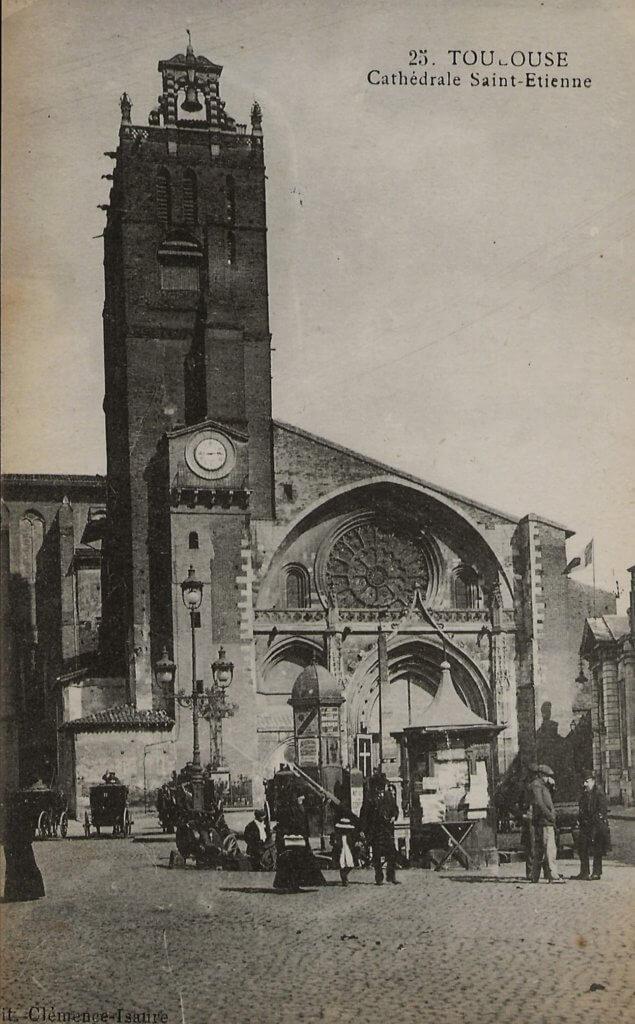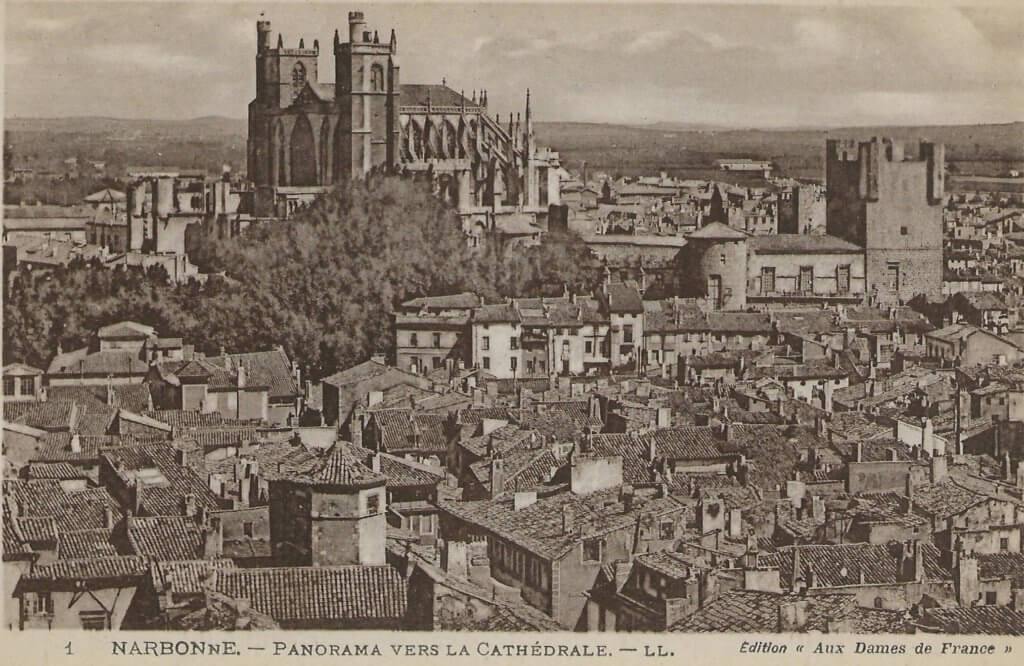Southern France, April 1919 [part 2]
Posted by Joel C. Swisher on April 14, '19
-
[Continued from part 1]

From Lourdes we went to Toulouse and spent a couple of hours there. It is a large town but had dirty streets. I did not think much of it. There were a couple of large churches there that were unusual because they were built with brick instead of stone. The first brick churches I have seen in France. We went on to Carcassonne where we spent the night.
Carcassonne is the chief center of French wool cleaning industry and is the dirtiest town I have seen. That is saying quite a bit. Carcasonne is world famous for the old fortified city on a hill behind the modern town. This old fortification with its double walls and numerous towers, etc; begun by the Romans and completed by the Western Goths. It is said to be the best examples of a fortified medieval city in France. There was a civil engineer in our party and he said that to him that was the most interesting thing of its kind he had ever seen.

From Carcassonne we went down a wide dry valley to Narbonne near the coast. That sections of France east from Carcassonne and down the coast from Narbonne to Perpignan is the first part of France I have seen where the rainfall is limited, in fact in this section I saw irrigation used quite a bit. Narbonne has nothing much to make it famous. It was warm and dry and surely was a relief to us who had spent the winter in Brest. We found a seat in a park and basked in the sun for four hours, it felt so good. One thing you notice about this section is appearance of the Spanish style of architecture. You see many little churches that look just like the pictures you see of Spanish missions in California. There is a large church in Narbonne, Spanish on the outside and Gothic on the inside. This church had some very beautiful red marble columns. That is another thing you notice in this district is the numerous uses they make of marble. Not only do they use in churches and such places but large fountains in the parks are of red marble, the house foundations and window and door casings are of that material. Doorsteps and the curb stones on nearly all the streets are of blue marble.
The railroad down the coast from Narbonne to Perpignan was in some places over a causeway separating arms of the Mediterranean from the sea itself. There is always a strong wind blowing off shore. Both times we went over it the day was perfectly clear but the wind blew so hard we could feel the train rock. On the night going down we had three or four miles of open water and salt marsh, back that the dry foot hills behind them and above them the white tops of the Pyrenees. On the left we can look out across the blue Mediterranean (and blue it is) with an occasional white sail on the horizon. Nearing Perpignan we go inland a bit and pass thru the town of Rivesaltes where Marshall Joffre(1)Joseph Joffre was commander-in-chief of the French forces on the western front in the early years of the war. was born. (Marshall Foch(2)Ferdinand Foch was Supreme Allied Commander for the last eight months of the war. by the way was born at Tarbes, a town just west of Toulouse(3)Actually, Tarbes is about 150km/90 miles from Toulouse, but only 25km/15 miles from Lourdes.), We arrived in Perpignan on the sixth evening.
We spent two nights and two days in this place. It is the best place in France for climate. If I were to make my home in France (which I never will) I would want to live in Perpignan. It is a town of about 40,000 in an exceedingly fertile valley, a few miles inland from the Mediterranean with the Pyrenees to the back of it. It is a great fruit district. Peaches, cherries and apricots and from the orchards to the sea are several square miles of vineyards. They cultivate their orchards and vineyards better in this district than in any other part of France. In Perpignan many of the houses, especially the new ones are white stucco with flat roofs and balcony about the upstairs windows. Palm trees stand between the house and the street.
One day we went on the trolley to the beach, about 10 miles and went bathing in the Mediterranean.
One day we took an electric line from Perpignan back into the mountains past orchards then vineyards, olive groves and into the mountains. Changing from standard to meter gauged we began to cross the mountains. Rising up the side of a valley thru numerous tunnels and over many bridges, mostly about 200 ft above the valley we finally reached the watershed, a few feet over a mile above sea level. The snowy peaks were still above us on both sides. Even along the track there were still many deep drifts. Crossing the watershed we descended toward the Spanish line. The railroad stopped at the line but we walked across a short distance in the company of an American military policeman. The Spaniards are none too friendly to Americans so the government allows no one to cross except for a very short distance. Coming back over the mountains the next morning we ran into a snowstorm which put a coat of ice on the third rail and we were delayed about an hour while they scraped the ice of the third rail. The sky cleared just at sunrise and we had the experience of watching a sunrise among snow covered mountains. It was glorious looking but mighty cold. When about noon we got off the train into the warmth and sunshine of Perpignan it was like coming out of an ice house in July.
When on the Spanish frontier we were also only about 10 miles from the Republic of Andorra. The smallest republic in the world.
When we planned the trip we had intended to see Marseilles and Nice also but just as we were leaving Brest [The letter ends here.]
Notes
Notes ↑1 Joseph Joffre was commander-in-chief of the French forces on the western front in the early years of the war. ↑2 Ferdinand Foch was Supreme Allied Commander for the last eight months of the war. ↑3 Actually, Tarbes is about 150km/90 miles from Toulouse, but only 25km/15 miles from Lourdes.